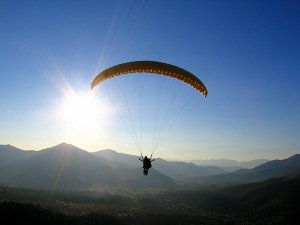I don’t normally bother to get upset about the weather. What’s the use? But after a week straight of rain and a sky the hue of funky dishwater, I am getting agitated. The farm is a mudhole so I can’t work–the tiller would get mired and the seedlings would rot. And I also can’t fly. And neither could the other pilots who were grounded in the rain the annual Starthistle Fly-in held at Woodrat over Memorial Day weekend. It’s feels so long since I’ve flown that the fact that I ever flew at all seems like an abstraction. A previous life.
So without the organizing forces of flying and working, my days feel hodgepodge like bad sculptures and my concerns are getting frilly. Like I’m wondering what to wear later this week when I oblige my friends to a girls-night-out to see the Sex and the City movie. At the same time I am lamenting about how our society insists I be shoe and clothing obsessed. Worse, I am lamenting about how I sort of am. All this makes me want to put my helmet on and block it all out. To run off the mountain, fly away, and see things in their proper proportions. An old pilot maxim declares that there is safety in altitude. This pilot was referring to terrain clearance, but what a metaphor …
So staring out into the rain, I’m feeling like there is no point. And the contrast makes me realize the tremendous role flying has in my life as of late, making my days feel utterly compelling–each flight a contemplation of the earth, of freedom and each landing a little survival that ignites the rest of the day.
It is fitting that I should pass the time watching Werner Herzog’s flim “The White Diamond” about a Brit who constructs ridiculous looking blimp–the “Jungle Airship”– and transports it to Peru to test it out under the incidental auspice of seaching for medicinal herbs in the cloud forest canopy. But really it’s all about obsession: with flying, with grandiosity.
The movie starts with a brief summary of aviation history nobly narrated by Herzog himself. As he depicts the success and failures of flight–from the first hot-air balloon ride to the Hindenburg–he proclaims flying “the great purpose.” As I pilot, I felt my spine straighten with pride when he said that: The Great Purpose! But the story quickly shrinks back to the Brit with his totally nonhistorical puffer-fish aircraft which, right before its first flight, gets rained on and turns into a wet rice wrapper. Days of waiting ensue and Herzog’s camera gets distracted by all manner of rainforest insect and then spaces out for a spell on a local guy breakdancing on a rock outcropping. Any paraglider pilot can relate to this–the fine art of waiting on weather, the restless antic-inspiring boredom. It is why the sport has earned the seconday name of “para-waiting.”
Anyway, after all this preparation and patience the Brit launches the Jungle Airship and has a sinky flight only to find he placed a motor in backwards.
And so Herzog subtly lets the air out of this overinflated endeavor. What is the purpose of flying, afterall?
There is none.
But the irony, which Herzog captures, is that when you are up in the air nothing could feel so compelling, so important, so crucial. Its profound and pointless simultaneously. Above all, it is joyful. And in the end, as a wise friend friend of mine recently pointed out: “Joy is a purpose unto itself. Maybe the only purpose, along with love.”

